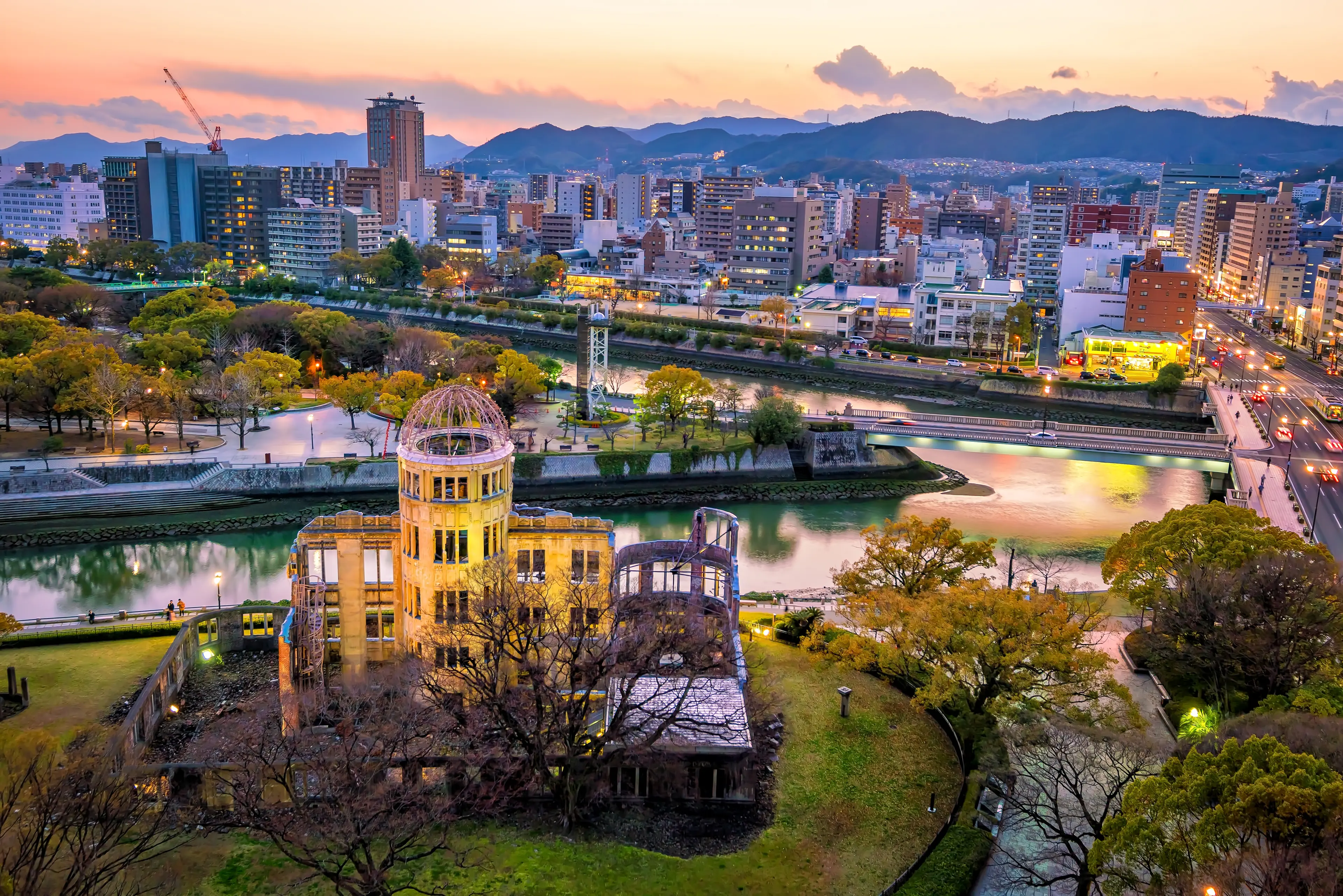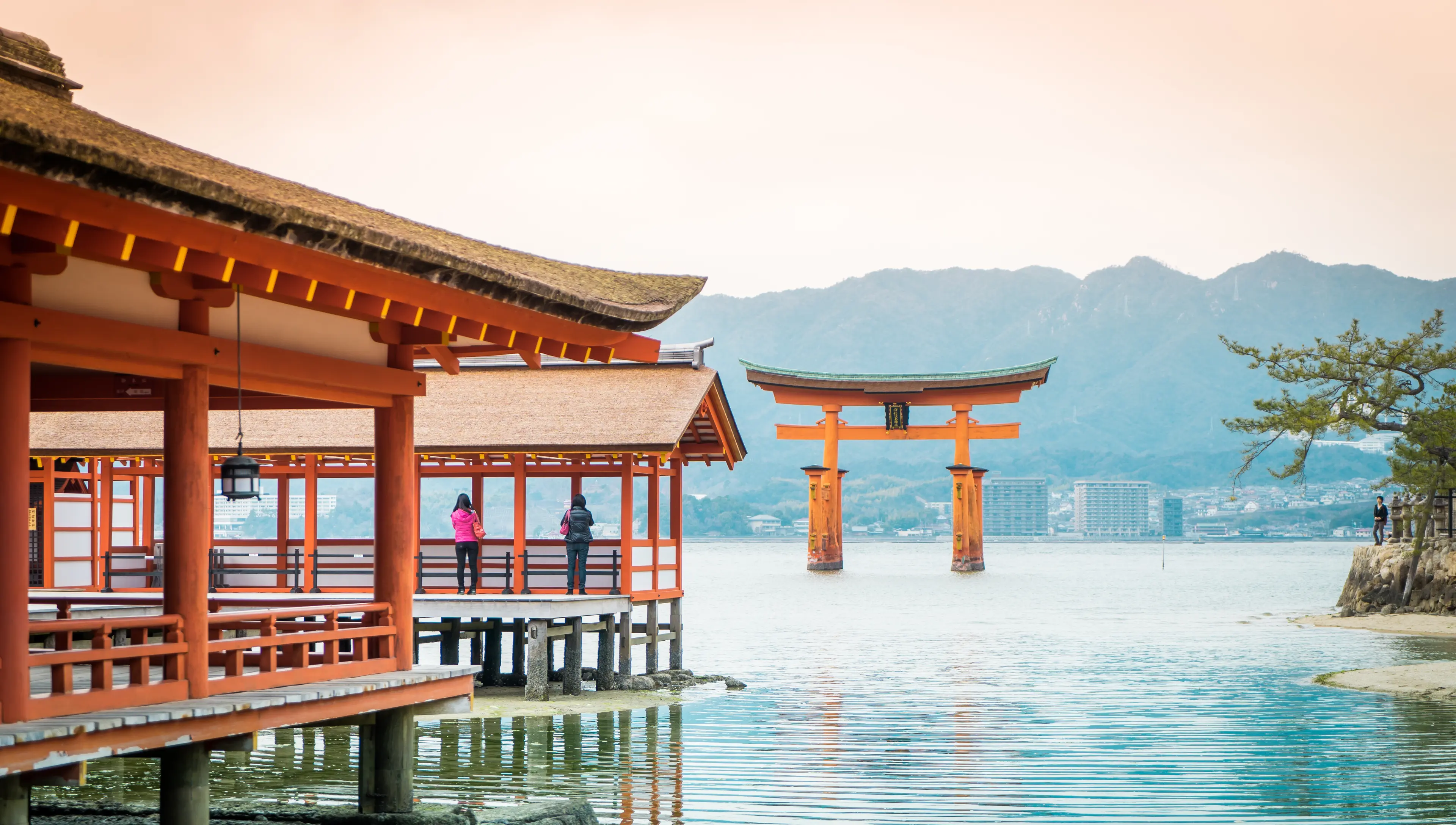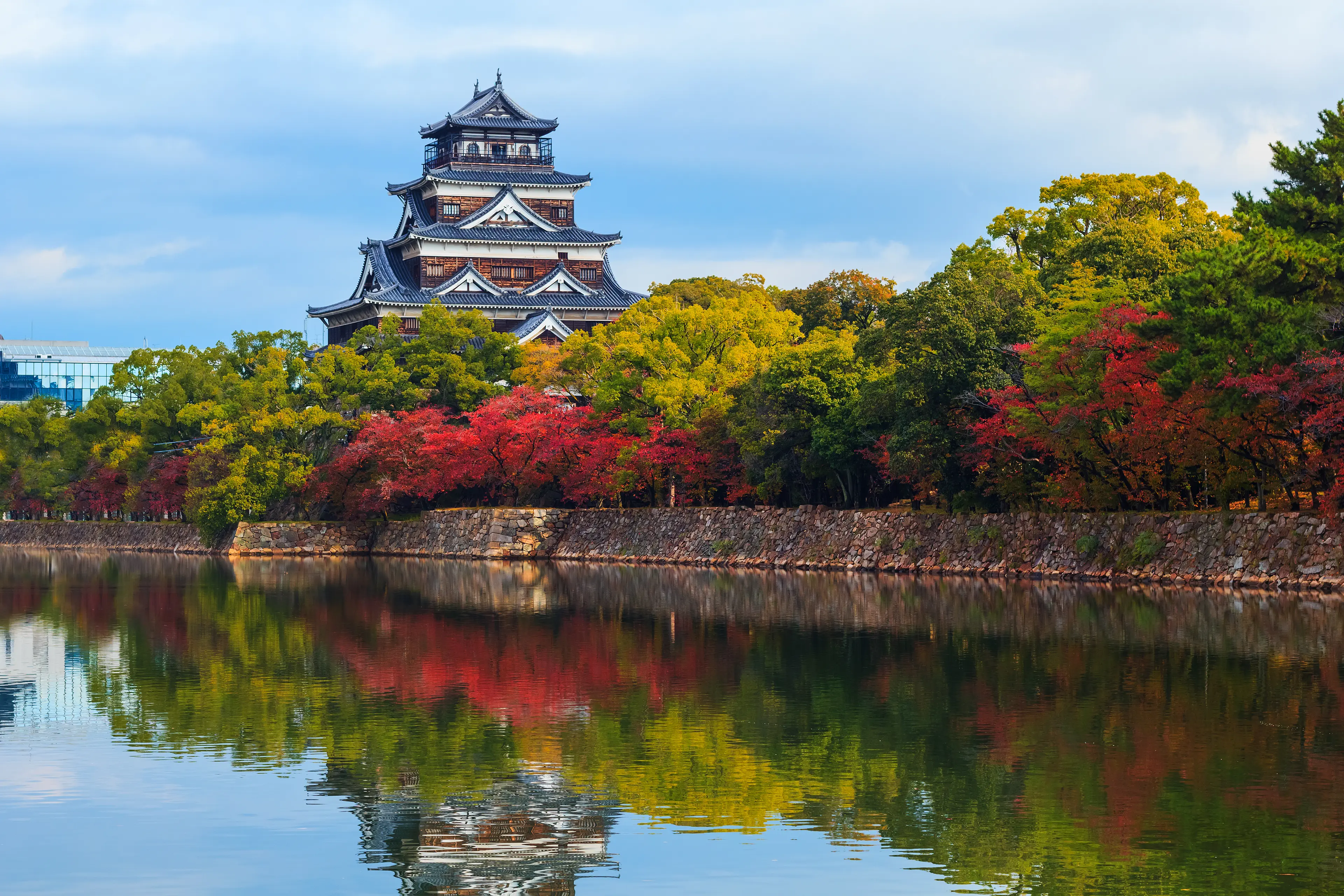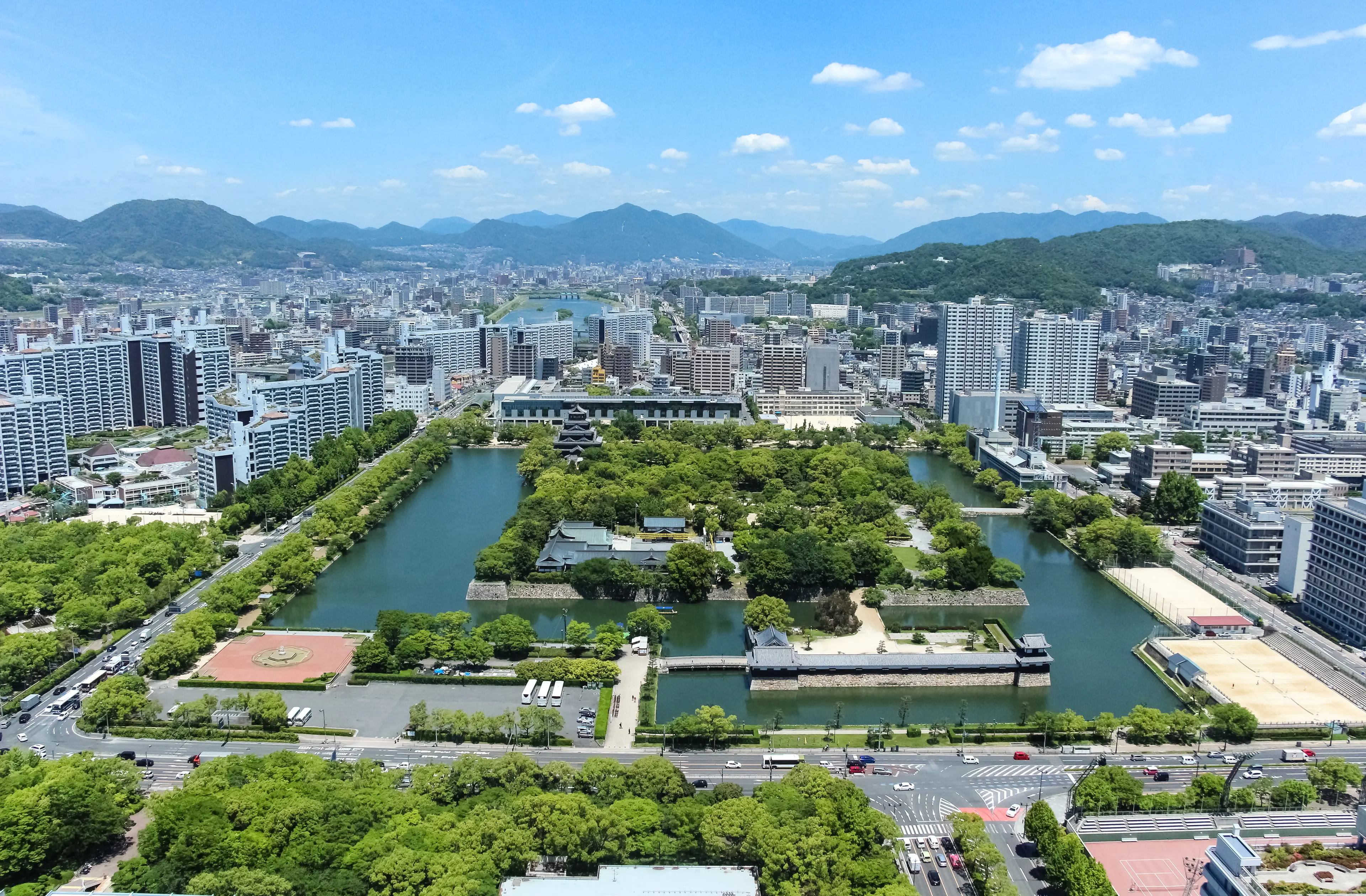1-Day Local Family Adventure in Hiroshima Outdoors
Hiroshima, Japan
1 days





About Hiroshima, Japan
Experience the rich history and vibrant culture of Hiroshima, Japan. This city, once devastated by the atomic bomb in 1945, has risen from the ashes and is now a symbol of peace and resilience. Visit the poignant Hiroshima Peace Memorial Park and Museum, where you can learn about the tragic event and its aftermath. Explore the beautiful Shukkei-en Garden, a perfect example of traditional Japanese landscaping. Don't miss the UNESCO World Heritage Site, Itsukushima Shrine, located on the nearby Miyajima Island, famous for its floating torii gate. Enjoy local delicacies like Hiroshima-style Okonomiyaki and fresh oysters. Hiroshima, a city of rebirth and beauty, awaits you.
1-Day Itinerary
Attractions in Itinerary (5)

1Hiroshima Peace Memorial Park
A beautiful park dedicated to the legacy of Hiroshima as the first city in the world to suffer a nuclear attack.

2Peace Memorial Museum
The Hiroshima Peace Memorial Museum is a museum located in Hiroshima Peace Memorial Park, dedicated to documenting the atomic bombing of Hiroshima in World War II. It is a place of education and reflection on the importance of peace and nuclear disarmament.

3A-Bomb Dome
A part of the Hiroshima Peace Memorial Park and was designated a UNESCO World Heritage Site in 1996. The ruin serves as a memorial to the people who were killed in the atomic bombing of Hiroshima on 6 August 1945.

4Hiroshima Castle
A castle that offers a great view of Hiroshima and a glimpse into its past.

5Motoyasu River
A river flowing through central Hiroshima. It is known for the beautiful views it offers of the city, especially of the Hiroshima Peace Memorial Park and the Atomic Bomb Dome. It is also a popular spot for cherry blossom viewing in spring.
Local Food and Drinks (12)

Hiroshima Okonomiyaki
A savory pancake filled with a variety of ingredients like cabbage, bean sprouts, pork, squid, and topped with a sweet sauce, mayonnaise, and green onions. It's a must-try dish that's synonymous with Hiroshima's local cuisine.

Anago Meshi
A popular dish in Hiroshima, Anago Meshi is a bowl of rice topped with grilled sea eel (anago). The eel is typically basted in a sweet soy-based sauce, giving the dish a unique, rich flavor.

Momiji Manju
A traditional Japanese sweet, Momiji Manju is a maple leaf-shaped cake filled with sweet red bean paste. It's a popular souvenir from Hiroshima, especially from Miyajima Island.

Hiroshima Oysters
Hiroshima is famous for its oysters, which are larger and meatier than most. They can be enjoyed in various ways such as raw, grilled, fried, or in a hot pot.

Tsukemen
A type of ramen where the noodles and broth are served separately. The noodles are dipped into the broth before eating. Hiroshima's version often includes local ingredients like oysters and lemons.

Kaki no Dotenabe
A hot pot dish featuring Hiroshima's famous oysters. The oysters are cooked in a pot with tofu, vegetables, and a miso-based broth.

Hiroshima Nihonshu
Hiroshima is known for its high-quality sake (Nihonshu). The region's soft water and favorable climate contribute to the production of a smooth and mild sake.

Yaki-gaki
Grilled oysters, a popular way to enjoy Hiroshima's famous oysters. They are typically grilled over charcoal and served with a squeeze of lemon.

Kumano Beef
A local brand of beef from the Kumano region of Hiroshima. Known for its marbling, tenderness, and rich flavor.
Chifun
A local Hiroshima dish made of thin rice noodles stir-fried with various ingredients like vegetables, meat, and seafood.
Hiroshima Lemon Sour
A refreshing cocktail made with Hiroshima's famous lemons. The lemons give the drink a fresh, tangy flavor.

Mikan Juice
A sweet and tangy juice made from Hiroshima's locally grown mikan (Japanese mandarin oranges).
Best time to visit
The best time to visit Hiroshima, Japan, is during the spring (March to May) and autumn (September to November) seasons. During these periods, the weather is typically mild and pleasant, and the scenery is at its most beautiful with cherry blossoms in spring and vibrant autumn leaves. These seasons also coincide with several cultural festivals, providing an excellent opportunity to immerse yourself in Japanese traditions. However, please note that these are also peak tourist seasons, so it's advisable to book accommodations and activities in advance.
How to get around
Tram
Hiroshima's tram network, also known as Hiroden, is one of the most extensive in Japan. It's a convenient and popular way to get around the city, with routes covering most major attractions including the Peace Memorial Park and Hiroshima Castle.
Bus
Hiroshima's bus network is extensive and can take you to places not covered by the tram. The Hiroshima Bus Terminal, located in the city center, is the main hub for local and long-distance buses.
Train
Hiroshima is well-connected by train to other cities in Japan via the Shinkansen (bullet train) network. Within the city, the JR Hiroshima Station is the main hub, with local lines providing access to suburban areas and nearby attractions like Miyajima.
Bicycle
Hiroshima is a bicycle-friendly city with numerous rental shops and dedicated bike lanes. It's a great way to explore the city at your own pace, especially the downtown area which is relatively flat and compact.
Taxi
Taxis are readily available throughout Hiroshima and can be hailed on the street or found at taxi ranks at major transport hubs and hotels. They offer a convenient but more expensive option for getting around.
Ridesharing
Ridesharing services like Uber are available in Hiroshima, offering a convenient and often cheaper alternative to taxis. They can be booked via smartphone apps.
Ferry
Ferries operate from Hiroshima Port to nearby islands, including the famous Miyajima Island. The ferry ride offers beautiful views of the Seto Inland Sea.
Car Rental
Renting a car can be a good option if you plan to explore outside of Hiroshima city, especially in more rural areas where public transport is less frequent. Note that an International Driving Permit is required for foreign drivers in Japan.
Foot
Many of Hiroshima's main attractions, including the Peace Memorial Park and Hiroshima Castle, are within walking distance of each other in the city center. Walking is a pleasant way to explore the city, especially in good weather.
Airport Shuttle Bus
The Hiroshima Airport is located about 50km east of the city. Shuttle buses run between the airport and the city center, providing a convenient transport option for air travelers.
Important information
Currency¥ JPY
Time zoneUTC+9
Driving sideLeft
Emergency phoneAmbulance: 119; Fire: 119; Police: 110
Drinking waterYes
Power sockets
Voltage100 V
Things to know about Hiroshima, Japan as a first time visitor
1
Hiroshima is located in the Chugoku Region on the western side of the main island of Honshu.
2
The city has a humid subtropical climate, with hot and humid summers (up to 90°F/32°C) and mild winters (down to 35°F/2°C).
3
The official language is Japanese, but English is commonly understood in tourist areas.
4
The local currency is the Japanese Yen (JPY). Credit cards are widely accepted, but it's a good idea to have some cash on hand for smaller establishments.
5
Hiroshima is in the Japan Standard Time zone, which is 9 hours ahead of Greenwich Mean Time (GMT +9).
6
Tipping is not customary in Japan, including Hiroshima. It can even be seen as rude, so it's best to avoid it.
7
Public transportation in Hiroshima is excellent. The city has a comprehensive tram system, buses, and ferries.
8
The city is known for its local delicacy, Hiroshima-style Okonomiyaki, a savory pancake you should try.
9
Hiroshima is a very safe city, but like anywhere, it's important to stay aware of your surroundings and keep your belongings secure.
10
The city has a wide range of accommodation options, from luxury hotels to traditional Japanese inns (ryokan) and budget hostels.
11
Hiroshima is a modern city with a tragic history. It's respectful to be mindful of this when visiting certain sites and interacting with locals.
12
The city is very pedestrian-friendly, with many areas accessible by foot or bicycle.
13
Tap water in Hiroshima is safe to drink, but bottled water is also readily available.
14
Public Wi-Fi is widely available in Hiroshima, including in many public spaces, cafes, and hotels.
15
Hiroshima has a vibrant nightlife, with many bars, restaurants, and entertainment venues open late into the night.
16
The city has a number of festivals throughout the year, including the Hiroshima Flower Festival in May and the Hiroshima Peace Memorial Ceremony in August.
17
Japanese etiquette is important. For example, it's customary to bow when greeting someone, and it's considered rude to eat or drink while walking in public.
18
Hiroshima has a number of shopping districts, offering everything from high-end fashion to traditional Japanese crafts.
19
The city is surrounded by beautiful nature, including the Seto Inland Sea and the Chugoku Mountains. It's worth taking a day trip to explore the surrounding area.
20
Emergency numbers in Japan are 110 for police and 119 for ambulance and fire services. It's a good idea to have these numbers saved in your phone.
Basic Japanese to know as a first time visitor
English phrase | Native phrase | Pronunciation | When to use it |
|---|---|---|---|
Hello | こんにちは | Konnichiwa | Greeting someone |
Goodbye | さようなら | Sayonara | Leaving or parting ways |
Please | お願いします | Onegaishimasu | Making a request |
Thank you | ありがとう | Arigatou | Showing gratitude |
Excuse me | すみません | Sumimasen | Getting attention or apologizing |
Yes | はい | Hai | Affirming or agreeing |
No | いいえ | Iie | Denying or disagreeing |
I don't understand | わかりません | Wakarimasen | When you don't understand something |
Do you speak English? | 英語を話せますか? | Eigo o hanasemasu ka? | When you need to communicate in English |
I'm sorry | ごめんなさい | Gomen nasai | Apologizing |
Where is the bathroom? | トイレはどこですか? | Toire wa doko desu ka? | When you need to find a bathroom |
How much does this cost? | これはいくらですか? | Kore wa ikura desu ka? | When you want to know the price of something |
I need help | 助けが必要です | Tasuke ga hitsuyou desu | When you need assistance |
Can I have the menu, please? | メニューをください | Menyū o kudasai | When you want to order food at a restaurant |
Water | 水 | Mizu | When you want to order water |
Beer | ビール | Bīru | When you want to order beer |
Delicious | おいしい | Oishii | Complimenting food |
I'm lost | 迷子になりました | Maigo ni narimashita | When you can't find your way |
Train station | 駅 | Eki | When you're looking for the train station |
Good night | おやすみなさい | Oyasuminasai | Before going to bed or parting late at night |
Packing List
Clothing
Comfortable walking shoes
Lightweight clothing
Rain jacket or umbrella
Sunglasses
Hat for sun protection
Toiletries
Travel-sized toothpaste
Toothbrush
Travel-sized shampoo and conditioner
Deodorant
Hand sanitizer
Face mask
Travel documents and essentials
Passport
Japanese Yen
Credit and debit cards
Hotel reservation confirmation
Travel insurance documents
Emergency contacts and important addresses
Electronics and gadgets
Smartphone
Charger for smartphone
Power bank
Headphones
Camera
Adapter plug
Miscellaneous items
Snacks
Water bottle
Travel guidebook for Hiroshima
Map of Hiroshima
Phrasebook or translation app
Backpack or daypack
Weather Conditions
Hiroshima, Japan, experiences a humid subtropical climate with four distinct seasons, which can greatly influence your travel plans. Spring (March to May) is a beautiful time to visit Hiroshima, with temperatures ranging from 50°F to 70°F (10°C to 21°C). It's the cherry blossom season, so don't forget to visit the parks and gardens. However, it's also a popular time for tourists, so expect some crowds. Summer (June to August) in Hiroshima is hot and humid, with temperatures often exceeding 86°F (30°C). It's also the rainy season, particularly in June and July, so pack an umbrella or raincoat. Despite the weather, summer is a vibrant time in Hiroshima, with numerous festivals taking place. Autumn (September to November) is another great time to visit Hiroshima. The temperatures are comfortable, ranging from 60°F to 75°F (15°C to 24°C), and the fall foliage is spectacular. It's also less crowded than spring. Winter (December to February) is relatively mild in Hiroshima, with temperatures usually between 35°F and 50°F (2°C to 10°C). Snowfall is rare but possible, so pack accordingly. Regardless of when you visit, it's always a good idea to check the local weather forecast before your trip and pack accordingly. Don't forget to bring comfortable shoes for exploring the city, and remember that the weather can change quickly, so it's always a good idea to carry a light jacket or umbrella.
| Month | Hi / Lo (°C) | Weather Overview |
|---|---|---|
January | 10° / 2° | January is the coldest month in Hiroshima, with occasional snowfall. It's a great time to visit if you enjoy cooler weather and fewer crowds. |
February | 11° / 2° | February is still quite cold, with a slight increase in temperature. It's a good time to visit museums and indoor attractions. |
March | 15° / 5° | March sees the arrival of spring, with cherry blossoms starting to bloom towards the end of the month. The weather is cool and comfortable for sightseeing. |
April | 20° / 10° | April is one of the best months to visit Hiroshima, with pleasant temperatures and full bloom of cherry blossoms. It's perfect for outdoor activities and sightseeing. |
May | 25° / 14° | May offers warm weather and is the start of the rainy season. It's a good time to visit Itsukushima Shrine and Hiroshima Peace Memorial Park. |
June | 29° / 19° | June is the rainy season in Hiroshima, with high humidity. However, the lush greenery and fewer crowds make it a unique time to visit. |
July | 34° / 24° | July is hot and humid, with occasional rain showers. It's a good time to visit indoor attractions or enjoy the city's vibrant nightlife. |
August | 34° / 24° | August is the hottest month in Hiroshima, with high humidity. It's a good time to visit the beaches or enjoy the city's summer festivals. |
September | 30° / 20° | September sees the end of summer, with temperatures starting to cool down. It's a great time to visit for outdoor activities and sightseeing. |
October | 24° / 14° | October offers comfortable temperatures and beautiful autumn foliage. It's a great time to visit parks and gardens. |
November | 19° / 9° | November is a beautiful month to visit Hiroshima, with autumn foliage at its peak. The weather is cool and comfortable for sightseeing. |
December | 14° / 4° | December is a cool month with occasional snowfall. It's a good time to visit if you enjoy Christmas festivities and cooler weather. |
Did you know?
Places near by Hiroshima, Japan

Miyajima Island
Famous for Itsukushima Shrine and its floating torii gate.

Okayama Korakuen Garden
One of the Three Great Gardens of Japan, known for its scenic beauty.

Kurashiki Bikan Historical Quarter
A beautifully preserved historical district with a canal lined with willow trees.

Himeji Castle
A UNESCO World Heritage Site, also known as White Heron Castle due to its elegant, white appearance.

Naoshima Island
Known as the 'Art Island', home to several contemporary art museums.

Kintaikyo Bridge
A historical wooden arch bridge, one of the country's three famous bridges.

Shimanami Kaido
A scenic 60km bike route that connects Honshu to Shikoku across six small islands.

Kotohira-gu Shrine
A Shinto shrine located halfway up Mount Zozu, known for its long stone staircase.

Akiyoshidai Plateau
The largest karst landscape in Japan with a massive limestone cave.

Tsuyama Castle
A hilltop Japanese castle with beautiful cherry blossom views in spring.